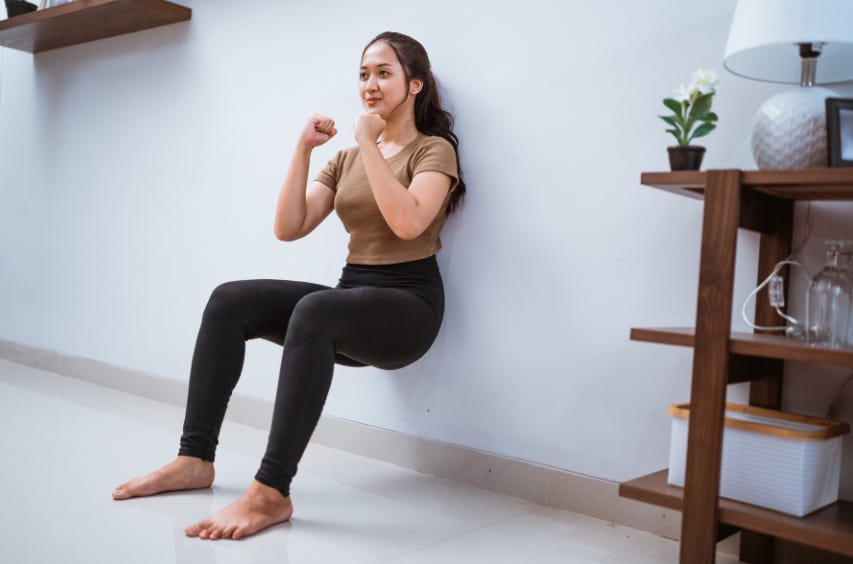Isometric exercises (IE) are movements where the same position is held, maintaining the same muscle length (as compared to the barbell curl, where a weight is raised and lowered). The muscles work by holding the body steady against gravity. This resistance helps to build strength. IEs are also a great option for those recovering from injury where the range of motion in a particular joint may be limited. Some examples include planks, dead hangs, glute bridges, and our feature movement for today’s workout, the Wall Squat (or Wall Sit).
How to do the Wall Squat (VIDEO DEMO)
Stand with your back against a stable wall. Keep your toes facing forward and feet hip-width apart.
While keeping your back against the wall, walk your feet out in front of you. Bend your knees and allow your back to slide down the wall until your thighs are parallel with the floor and the knee is at a 90-degree angle. If this is not accessible to you, hold the squat higher up (knee is at 45 degrees).
Hold your squat for five seconds or up to one minute, depending on your ability or what is prescribed in your workout. Make sure you feel your weight in your heels, not your toes.
To get out of a wall sit, push your palms against the wall and bend forward at your hips. Or bring one foot back toward the wall and slide your body up.
Great for core strength and may reduce back pain
Burns fat
No equipment required
Accessible to all fitness levels by adjusting the depth of the squat
Improves posture
Lowers blood pressure
Builds quadriceps strength
Helps with balance
Can reduce knee pain
Interestingly, isometric exercises - particularly the Wall Sit - have been shown to help reduce high blood pressure in more than 30 randomized controlled trials, supported by individual patient-level and group-level meta-analyses. Historically, there has been some debate in the medical community about the safety of these movements in individuals with heart disease and hypertension. However, abundant research showing favorability since the 1990s has largely reversed this sentiment among most in the community.
Today’s workout integrates two isometric movements - the Wall Sit and the High Plank Hold - into a spicy quadruplet of movements that also target lower body and cardiovascular strength and stamina, complete with plyometrics for the bones. All in just 15 minutes! Enjoy!
Warm Up
TABATA (20 seconds of work, 10 seconds of rest x 8 rounds). Perform each movement in sequence for 20 seconds, then rest 10 seconds before starting the next movement. You will complete the set of 4 movements 4 times.
Easy push-ups (elevated or on your knees)
Ab mat (use a rolled towel or ab mat) or traditional sit-ups.
Movement Practice
Select a moderate weight for the dumbbell thrusters that you can perform the 5 repetitions unbroken, consistently. Using one of your chosen dumbbells, practice the burpee over the dumbbell. Ideally, jump over the dumbbell; however, if this is not accessible to you, you may step over the dumbbell.
Test out the Wall squat and the High plank hold. Review the linked videos to be sure you are performing the movements with proper form. Your positioning should be pain-free on your joints. Make adjustments by changing the depth of your squat, or by elevating the plank on a bench, box, stable chair, or step. Choose options that allow you to hold the movement for the full 15 seconds.
Workout
AMRAP 15 (As many rounds as possible in 15 minutes). Perform each movement in sequence for as many rounds of the 4 movements as possible within the 15-minute time domain.
5 Dumbbell Thrusters (Modify with air squats or goblet squats if overhead movement is limited)
5 Burpees over the dumbbell (Jump or step over the dumbbell)
15-second Wall sit
15-second High plank hold (knees or toes)
Score: Number of completed rounds and repetitions in 15 minutes.
Cool Down
Jump start your recovery with this 20-minute “Quick Escape” Yoga class from Five Parks. I cannot overstate the importance of stretching and recovery during midlife. So please, #dontskiptheyoga
Check out my latest podcast appearance on “I’ll Have Another” with Lindsey Hein.
Join us for a lively discussion about all the ways athletic women can thrive through perimenopause and menopause!
NOW TAKING NEW CLIENTS!
If you are an active woman or competitive midlife athlete who feels abandoned by mainstream medicine, I’m here for you!
It is with great excitement that after more than 2 years of preparation, I have FINALLY launched my Telehealth Consultation Medical practice focusing on the Reproductive Endocrine needs and Menopausal Care for active, athletic, and high-performing women.
Active and athletic midlife women have needs and risk profiles that are different from the general population. These needs often go unmet by the mainstream medical community due to a lack of understanding of fitness and sport and their impact on mid-life hormonal physiology or even a lack of acknowledgment that this dynamic exists. We put your health, fitness, and performance at the center of the equation so that you can achieve your healthiest, highest-performing self!
You will find all my service offerings on my website including a link to my calendar so that you can reserve your place in my schedule!




